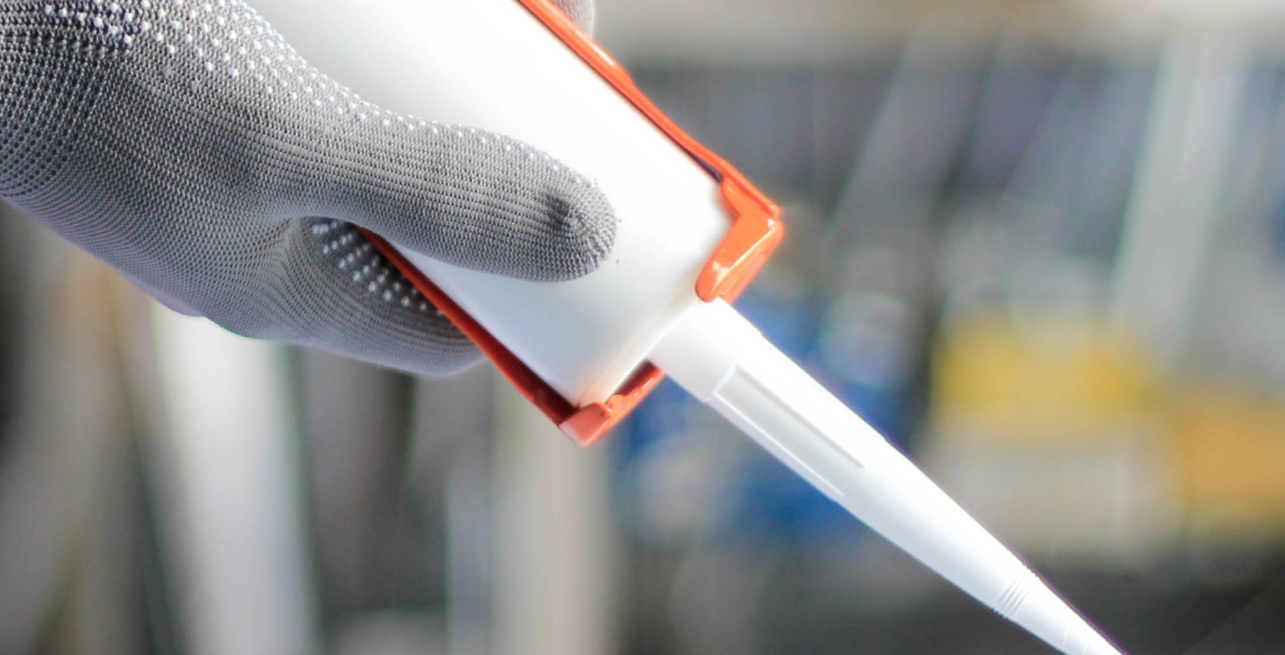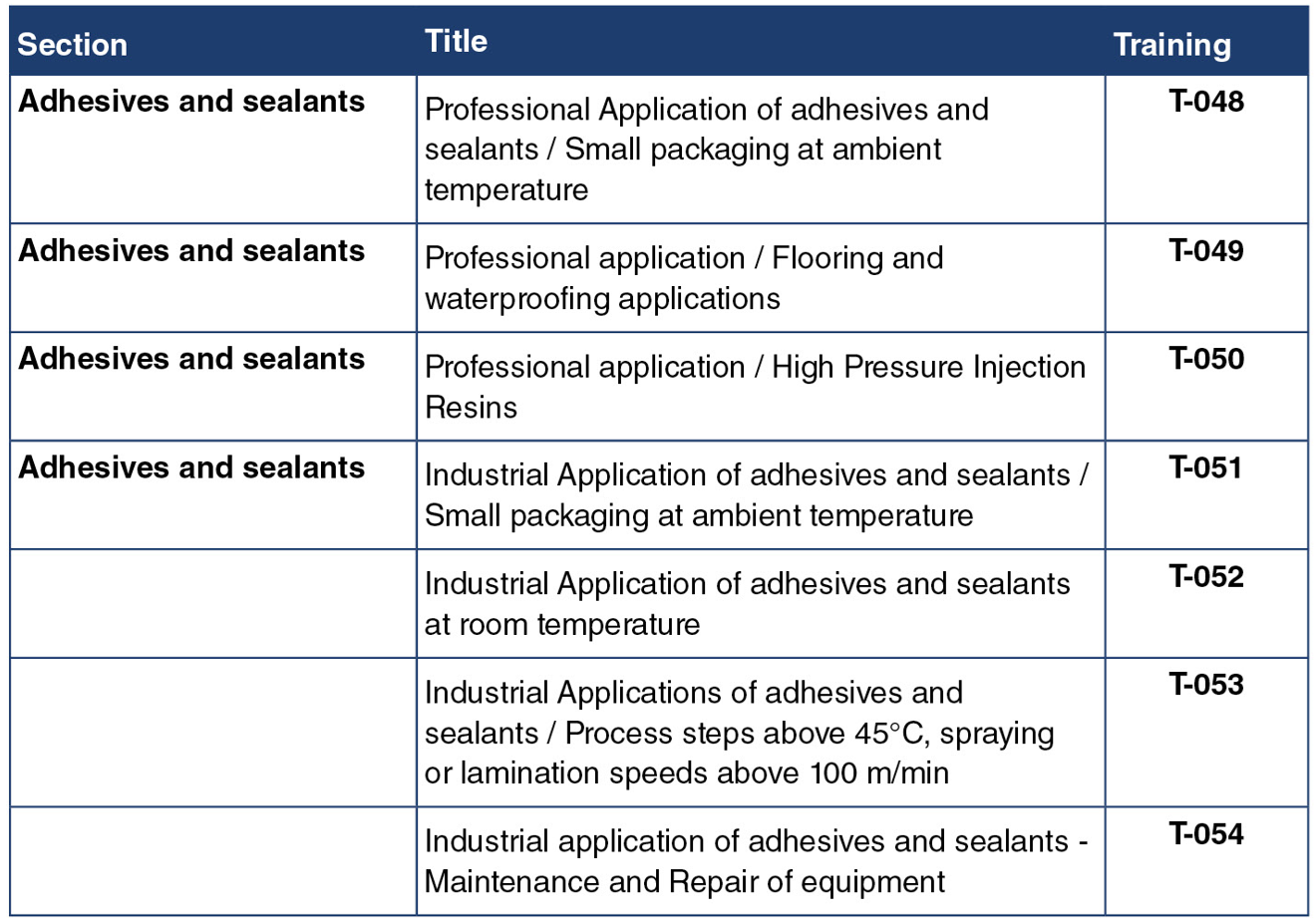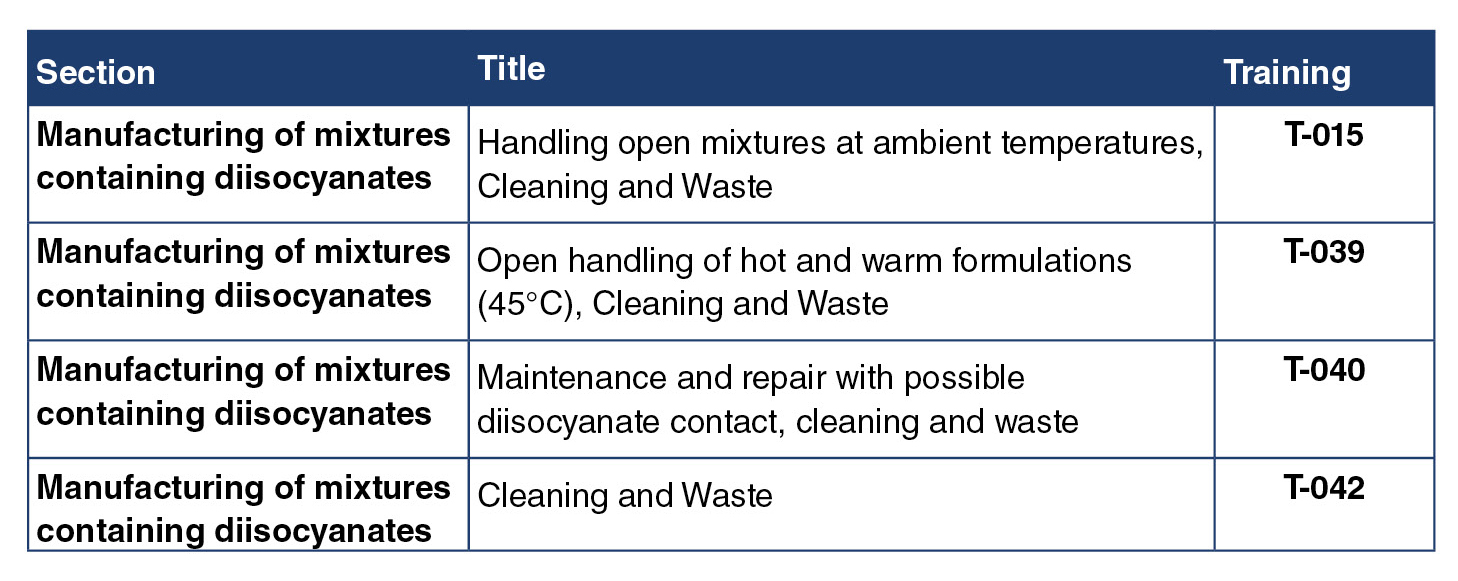 Safe use of diisocyanates
Safe use of diisocyanates
A new restriction on diisocyanates was adopted on 4 August 2020, by the European authorities under REACH, targeting respiratory and dermal sensitisation potentially caused by diisocyanates. Details of this restriction can be found in all EU languages via EUR-Lex, the European Union's website offering access to EU law. The new restriction requires training prior to use for diisocyanates. The restriction also requires adhesives and sealants manufacturers to:
- provide end users with information about the training on the safe use of diisocyanates
- ensure, from 24 February 2022, that all PU products for which safety training is required bear the following statement on the label: 'As of 24 August 2023, adequate training is required before industrial or professional use of this product.
Polyurethane (PU) Training
As of 24 August 2023, training is required for all professional and industrial users of products with a total monomeric diisocyanate concentration of > 0.1%.
FEICA, in coordination with the European Diisocyanate & Polyol Producers Association (ISOPA), the European Aliphatic Isocyanates Producer Association (ALIPA), and several other industries in the polyurethane (PU) industry, launched a comprehensive training programme to ensure the safe use of diisocyanates for producers and professional users all over Europe. In this way, FEICA also ensures that all end-users of PU containing adhesives and sealants across Europe continue to handle diisocyanates safely.
The PU Training Platform can be accessed via www.safeusediisocyanates.eu and is accessible across the EU. If you are a manufacturer of PU adhesives or sealants, you will need to be trained on the safe handling of diisocyanates.
If you are a FEICA member or a member of a FEICA National Association (NAM), you can access further guidance on how to train your staff via the FEICA Extranet.
Information provision requirement
![]() To facilitate adhesive and sealant companies to comply with the information provision requirement, a dedicated FEICA information webpage was made available:
To facilitate adhesive and sealant companies to comply with the information provision requirement, a dedicated FEICA information webpage was made available:
www.feica.eu/PUinfo
A link to this webpage (or QR code) can be added to adhesives and sealants labels to direct to the training platform.
Additional sources of information
FEICA's PU Restriction Technical Working Group (TWG) created a leaflet titled 'A safe future for polyurethane products' to explain more about the restriction. It is available in 8 European languages:
- A safe future for polyurethane products (English, FEICA)
- A safe future for polyurethane products (English, BASA)
- Eine sichere Zukunft für Polyurethan-Produkte (German, IVK and DB)
- Un avenir sûr pour les produits en polyuréthane (French, AFICAM)
- Un avenir sûr pour les produits en polyuréthane (French, DETIC)
- Un futuro seguro para los productos de poliuretano (Spanish, ASEFCA)
- Bezpieczna przyszłość produktów poliuretanowych (Polish, PZPFiK)
- Un futuro all’insegna della sicurezza per I prodotti poliuretanici (Italian, AVISA)
- Een veilige toekomst voor polyurethaanproducten (Dutch, VLK)
- Een veilige toekomst voor polyurethaanproducten (Dutch, DETIC)
- Varna uporaba izdelkov iz poliuretana (Slovenian, GZS)
More specific information for end-users was made available via the leaflet ‘Diisocyanates restriction compliance for end-users of adhesives and sealants'. It is also available in 8 European languages:
- Diisocyanates restriction compliance for end-users of adhesives and sealants (English, FEICA)
- Diisocyanates restriction compliance for end-users of adhesives and sealants (English, BASA)
- Diisocyanat-Beschränkungen für Endverbraucher von Kleb- und Dichtstoffen (German, IVK and DB)
- Restriction des diisocyanates dans les colles et mastics pour les utilisateurs finaux (French, AFICAM)
- Restriction des diisocyanates dans les colles et mastics pour les utilisateurs finaux (French, DETIC)
- Restricción sobre diisocianatos para usuarios finales de adhesivos y selladores (Spanish, ASEFCA)
- Zgodność z ograniczeniem dotyczącym diizocyjanianów dla użytkowników końcowych klejów i uszczelniaczy (Polish, PZPFiK)
- Conformità alle restrizioni sui diisocianati per utilizzatori finali di adesivi e sigillanti (Italian, AVISA)
- Naleving van de diisocyanaten-restrictie voor eindgebruikers van lijmen en kitten (Dutch, DETIC)
- Naleving van de diisocyanaten-restrictie voor eindgebruikers van lijmen en kitten (Dutch, VLK)
- Skladnost z omejitvami glede diizocianatov za končne uporabnike lepil in tesnil (Slovenian, GZS)
In addition, a FEICA article titled 'A safe future for polyurethane products', was published in the December 2021 issue of the European Coatings Journal.
Overview of Training Modules related to adhesives and sealants
For users of adhesives and sealants containing diisocyanates:

For manufacturers of adhesives and sealants:

FAQ
PU adhesives and sealants are versatile, innovative and safe. They are used in a wide variety of applications in construction, packaging, automotive, furniture, engineering, marine, transportation, and many more. PU products are made by reacting diisocyanates and polyols.
Below are some frequently asked questions on the safe use of polyurethane products, answered.
Like that of any other substances, diisocyanates’ use is safe when chemicals are handled according to relevant risk management and safety measures. It is also important to stress that virtually no diisocyanates can be found in finished articles. Diisocyanates are used only as reactive chemicals; they react with the polyol to form the PU product and are used up during the reaction.
Sensitisation means that after exposure, a person could become allergic to the substance. If sensitised, each time the person is in contact again with the substance (even at very low concentrations) the person could have a highly allergic reaction with respiratory impacts (e.g. asthma). The majority of individuals with diisocyanates-related asthma show improvement or total recovery after exposure has ceased.
There is more than one possible method.
The method CAM-0642303-18E is owned by CURRENTA GmbH & Co OHG, and FEICA has a non-exclusive and non-transferable license.
As FEICA holds a license, its members can refer to this license to receive a customer-specific discount.
However, as a non-member, please note that you can buy a license at full price from CURRENTA.
The criterion for knowing whether the application of A&S is professional or industrial is the work location. If the application is performed within an industrial facility, then it is an industrial application. Professional applications of A&S are normally performed within the construction sector, or by professionals in auto repair shops or similar locations outside an industrial setting.
Since 24 February 2022, the sentence 'as of 24 August 2023, adequate training is required before industrial or professional use of this product' should appear on the packaging of the product.
Whether the brand owner or the producer/filler takes the initiative is irrelevant. In the end, the users must be informed via the label of the packaging.
Please note that the REACH restriction on diisocyanates does not refer to ‘placing on the market’. However, the brand owner is making the product available to the end users, and therefore responsible for making sure the information is provided.
The new regulation only applies to professionals and industry. A separate restriction for consumer use came into force several years ago.
If the importer and his personnel are exposed to diisocyanates when they are opening drums or pouring out drums in a facility in the European Union, then they will have to be trained because that is industrial use. But if they are only shipping products and they do not have potential exposure to the products, then this is like any other shipping activity.
The new regulation was adopted on 4 August 2020 and came into force on 24 August 2020. After a three-year transition phase, by 24 August 2023, all users of PU products should be trained and certified.
The legal requirements should appear on the packaging as of 24 February 2022.
The restriction is targeted at avoiding unsafe handling of diisocyanates, not on restricting product availability. Due to their unique properties in many applications, PU adhesives and sealants will remain widely available.
No, the supplier must ensure that the professional or industrial customer is provided with information about the training requirements. That the customer or user reads the information or even acknowledges receipt of it is not required by the regulation. Furthermore, the supplier must put the following statement on the packaging: ‘As from 24 August 2023, adequate training is required before industrial or professional use’. A confirmation of receipt from the customer is not required.
The supplier has to make sure that the training according to the requirements of the restriction is available to the users. Suppliers do not need to organise training sessions themselves. To this end, FEICA, together with ISOPA and ALIPA, the diisocyanate manufacturers’ industry associations, have prepared training material in line with the legal requirements, which is available in English from November 2021 and will be made available in all the European Union languages by the middle of 2022. The training material is available via an e-learning platform which accommodates online training, webinar sessions or classroom training given by external trainers or organised in-house. While the supplier is responsible for providing its customer with information about the training, the employer is responsible for ensuring that the training is completed by its employees and that this completion is documented.
There is not a specific training module for managers or supervisors. Managers and supervisors should be trained by the same training modules as the employees they are responsible for.
Company X Germany GmbH, having a trainer account, is allowed to train all employees of Company X on a group level, including, e.g. employees of Company X France SA. Company X France SA could also request its own trainer account; however, there would be a charge for this. It is a business decision by Company X whether to have one training account for the entire group or to have multiple training accounts for several legal entities.
For further info on receiving a trainer account, please contact ISOPA/ALIPA or check out www.safeusediisocyanates.eu
A certificate will be issued to show successful completion of the training. The test questions come from a large pool of questions related to the training material, and if you have successfully passed the tests, then you will receive the certificate.
Your supplier will help you with any product-related questions. If you would like to learn more about the status of training developments or other related general topics, please contact FEICA at info@feica.eu.
The diisocyanates industry provides information about diisocyanates and their safe handling on its website.
